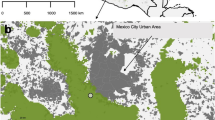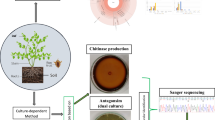Abstract
Nepenthes pitcher plants produce modified jug-shaped leaves to attract, trap and digest insect prey. We used 16S rDNA cloning and sequencing to compare bacterial communities in pitcher fluids of each of three species, namely Nepenthes ampullaria, Nepenthes gracilis and Nepenthes mirabilis, growing in the wild. In contrast to previous greenhouse-based studies, we found that both opened and unopened pitchers harbored bacterial DNA. Pitchers of N. mirabilis had higher bacterial diversity as compared to other Nepenthes species. The composition of the bacterial communities could be different between pitcher types for N. mirabilis (ANOSIM: R = 0.340, p < 0.05). Other Nepenthes species had similar bacterial composition between pitcher types. SIMPER showed that more than 50 % of the bacterial taxa identified from the open pitchers of N. mirabilis were not found in other groups. Our study suggests that bacteria in N. mirabilis are divided into native and nonnative groups.







Similar content being viewed by others
References
Amann RI, Ludwig W, Schleifer KH (1995) Phylogenetic identification and in situ detection of individual microbial cells without cultivation. Microbiol Rev 59:143–169
Bauer U, Willmes C, Federle W (2009) Effect of pitcher age on trapping efficiency and natural prey capture in carnivorous Nepenthes rafflesiana plants. Ann Bot 103:1219–1226
Bauer U, Grafe TU, Federle W (2011) Evidence for alternative trapping strategies in two forms of the pitcher plant, Nepenthes rafflesiana. J Exp Bot 62:3683–3692
Beaver RA (1983) The communities living in Nepenthes pitcher plants: fauna and food webs. In: Frank JH, Lounibos LP (eds) Phytotelmata: plants as hosts for aquatic insect communities. Plexus, Medford, pp 129–159
Beaver RA (1985) Geographical variation in food web structure in Nepenthes pitcher plants. Ecol Entomol 10:241–248
Bhore SJ, Komathi V, Kandasamy KI (2013) Diversity of endophytic bacteria in medicinally important Nepenthes species. J Nat Sci Biol Med 4:431–434
Bonhomme V, Pelloux-Prayer H, Jousselin E, Forterre Y, Labat JJ, Gaume L (2011) Slippery or sticky? Functional diversity in the trapping strategy of Nepenthes carnivorous plants. New Phytol 191:545–554
Buch F, Rott M, Rottloff S, Paetz C, Hilke I, Raessler M, Mithöfer A (2012) Secreted pitfall-trap fluid of carnivorous Nepenthes plants is unsuitable for microbial growth. Ann Bot 111:375–383
Buckley HL, Miller TE, Ellison AM, Gotelli NJ (2010) Local to continental-scale variation in the richness and composition of an aquatic food web. Glob Ecol Biogeogr 19:711–723
Clarke KR (1993) Non-parametric multivariate analyses of changes in community structure. Aust J Ecol 18:117–143
Clarke CM (1997) Nepenthes of Borneo. Natural, Kota Kinabalu
Clarke CM (2001) Nepenthes of Sumatra and Peninsular Malaysia. Natural, Kota Kinabalu
Clarke KR, Gorley R (2006) Primer v6: user manual/tutorial. Primer-E, Plymouth
Di Giusto B, Grosbois V, Fargeas E, Marshall DJ, Gaume L (2008) Contribution of pitcher fragrance and fluid viscosity to high prey diversity in a Nepenthes carnivorous plant from Borneo. J Biosci 33:121–136
Di Giusto B, Rowe N, Gaume L (2009) The waxy surface in Nepenthes pitcher plants: variability, adaptive significance and developmental evolution. In: Gorb SN (ed) Functional surfaces in biology. Springer Science+Business Media, New York, pp 183–203
Di Giusto B, Bessière JM, Guéroult M, Lim LBL, Marshall DJ, Hossaert-McKey M, Gaume L (2010) Flower-scent mimicry masks a deadly trap in the carnivorous plant Nepenthes rafflesiana. J Ecol 98:845–856
Gaume L, Forterre Y (2007) A viscoelastic deadly fluid in carnivorous pitcher plants. PLoS One 2:e1185
Gorb SV, Gorb SN (2006) Physicochemical properties of functional surfaces in pitchers of the carnivorous plant Nepenthes alata Blanco (Nepenthaceae). Plant Biol 8:841–848
Harrigan W, McCance M (1976) Laboratory methods in food and dairy microbiology. Academic Press, New York
Hatano N, Hamada T (2008) Proteome analysis of pitcher fluid of the carnivorous plant Nepenthes alata. J Proteome Res 7:809–816
Hatano N, Hamada T (2012) Proteomic analysis of secreted protein induced by a component of prey in pitcher fluid of the carnivorous plant Nepenthes alata. J Proteomics 75:4844–4852
Hepburn JS (1918) Biochemical studies of the pitcher liquor of Nepenthes. Proc Am Philos Soc 57:112–129
Hepburn JS, St John EQ (1927) A bacteriological study of the pitcher liquor of the Sarraceniaceae. Trans Wagner Free Inst Sci Phila 11:75–83
Higashi S, Nakashima A, Ozaki H, Abe M (1993) Analysis of feeding mechanism in a pitcher of Nepenthes hybrida. J Plant Res 106:47–54
Huber T, Faulkner G, Hugenholtz P (2004) Bellerophon: a program to detect chimeric sequences in multiple sequence alignments. Bioinformatics 20:2317–2719
Kato M, Hotta M, Tamin R, Itino T (1993) Inter- and intra-specific variation in prey assemblages and inhabitant communities in Nepenthes pitchers in Sumatra. Trop Zool 6:11–25
Lloyd FE (1942) The carnivorous plants. Chronica Botanica Co., Waltham
Marchesi JR, Sato T, Weightman AJ, Martin TA, Fry JC, Hiom SJ, Wade WG (1998) Design and evaluation of useful bacterium-specific PCR primers that amplify genes coding for bacterial 16S rRNA. Appl Environ Microbiol 64:795–799
Moran JA (1996) Pitcher dimorphism, prey composition and the mechanisms of prey attraction in the pitcher plant Nepenthes rafflesiana in Borneo. J Ecol 84:515–525
Morohoshi T, Oikawa M, Sato S, Kikuchi N, Kato N, Ikeda T (2011) Isolation and characterization of novel lipases from a metagenomic library of the microbial community in the pitcher fluid of the carnivorous plant Nepenthes hybrida. J Biosci Bioeng 112:315–320
Oliver JD (2005) The viable but nonculturable state in bacteria. J Microbiol 43:93–100
Pankratov TA, Belova S, Dedysh S (2005) Evaluation of the phylogenetic diversity of prokaryotic microorganisms in sphagnum peat bogs by means of fluorescence in situ hybridization (FISH). Microbiology 74:722–728
Peet RK (1974) The measurement of species diversity. Annu Rev Ecol Syst 5:285–307
Riedel M, Eichner A, Meimberg M, Jetter R (2007) Chemical composition of epicuticular wax crystals on the slippery zone in pitchers of five Nepenthes species and hybrids. Planta 225:1517–1534
Scholz I, Bückins M, Dolge L, Erlinghagen T, Weth A, Hischen F, Mayer J, Hoffmann S, Riederer M, Riedel M, Baumgartner W (2010) Slippery surfaces of pitcher plants: Nepenthes wax crystals minimize insect attachment via microscopic surface roughness. J Exp Biol 213:1115–1125
Sim JWS, Tan HTW, Turner IM (1992) Adinandra belukar: an anthropogenic heath forest in Singapore. Vegetatio 102:125–137
Siragusa AJ, Swenson JE, Casamatta DA (2007) Culturable bacteria present in the fluid of the hooded-pitcher plant Sarracenia minor based on 16S rDNA gene sequence data. Microbial Ecol 54:324–331
Sota T, Mogi M, Kato K (1998) Local and regional-scale food web structure in Nepenthes alata pitchers. Biotropica 30:82–91
Takeuchi Y, Salcher MM, Ushio M, Shimizu-Inatsugi R, Kobayashi MJ, Diway B, von Mering C, Pernthaler J, Shimizu KK (2011) In situ enzyme activity in the dissolved and particulate fraction of the fluid from four pitcher plant species of the genus Nepenthes. PLoS One 6:e25144
Thornhill AH, Harper IS, Hallam ND (2008) The development of the digestive glands and enzymes in the pitchers of three Nepenthes species: N. alata, N. tobaica, and N. ventricosa (Nepenthaceae). Int J Plant Sci 169:615–624
Ugland KI, Gray JS, Ellingsen KE (2003) The species-accumulation curve and estimation of species richness. J Anim Ecol 72:888–897
Author information
Authors and Affiliations
Corresponding author
Additional information
Communicated by Erko Stackebrandt.
Rights and permissions
About this article
Cite this article
Chou, L.Y., Clarke, C.M. & Dykes, G.A. Bacterial communities associated with the pitcher fluids of three Nepenthes (Nepenthaceae) pitcher plant species growing in the wild. Arch Microbiol 196, 709–717 (2014). https://doi.org/10.1007/s00203-014-1011-1
Received:
Revised:
Accepted:
Published:
Issue Date:
DOI: https://doi.org/10.1007/s00203-014-1011-1




